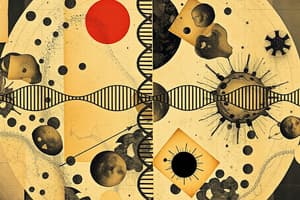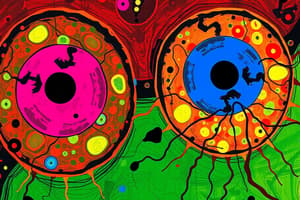Podcast
Questions and Answers
Which of the following events occur during prophase I? (Select all that apply)
Which of the following events occur during prophase I? (Select all that apply)
- Movement of centrosomes (correct)
- Separation of homologous chromosomes
- Breakdown of the nuclear envelope (correct)
- Condensation of chromosomes (correct)
Which of the following events occurs during anaphase I?
Which of the following events occurs during anaphase I?
- Separation of sister chromatids
- Separation of homologous chromosomes (correct)
- Condensation of chromosomes
- Formation of the nuclear envelope
At the end of meiosis I, there are two haploid cells, each with two sister chromatids per chromosome.
At the end of meiosis I, there are two haploid cells, each with two sister chromatids per chromosome.
True (A)
At the end of meiosis II, there are?
At the end of meiosis II, there are?
In animal cells, cytokinesis is accomplished by the formation of a cleavage furrow.
In animal cells, cytokinesis is accomplished by the formation of a cleavage furrow.
Separation of ________ occurs in anaphase II of meiosis.
Separation of ________ occurs in anaphase II of meiosis.
What is the overall purpose of meiosis?
What is the overall purpose of meiosis?
The exchange of genetic material between nonsister chromatids is called what and occurs during which phase of meiosis?
The exchange of genetic material between nonsister chromatids is called what and occurs during which phase of meiosis?
Select from the following list of statements all of the ways in which meiosis II differs from meiosis I.
Select from the following list of statements all of the ways in which meiosis II differs from meiosis I.
What cells in the body are most likely to have originated through the process of meiosis?
What cells in the body are most likely to have originated through the process of meiosis?
If a sperm cell contains 8 chromosomes, it comes from an animal that has ______ chromosomes.
If a sperm cell contains 8 chromosomes, it comes from an animal that has ______ chromosomes.
Flashcards are hidden until you start studying
Study Notes
Meiosis Overview
- Meiosis is a two-stage cell division process that produces four genetically diverse haploid cells.
- It consists of two main phases: Meiosis I and Meiosis II.
Prophase I Events
- Breakdown of the nuclear envelope occurs.
- Chromosomes condense, becoming visible under a microscope.
- Centrosomes move to opposite poles of the cell.
Anaphase I and II Events
- In Anaphase I, homologous chromosomes separate and move towards opposite poles.
- In Anaphase II, sister chromatids are separated and pulled to opposite ends of the cell.
Cellular Outcomes
- At the end of Meiosis I, there are two haploid cells, each containing two sister chromatids per chromosome.
- At the end of Meiosis II, four haploid cells are produced, and each chromosome consists of a single chromatid.
Cytokinesis in Animal Cells
- In animals, cytokinesis occurs via the formation of a cleavage furrow, pinching the cell in two.
Genetic Variation
- Crossing-over occurs during Prophase I, where genetic material is exchanged between nonsister chromatids, enhancing genetic diversity.
Differences Between Meiosis I and II
- Meiosis II differs from Meiosis I as it involves no chromosome replication during interkinesis.
- Crossing-over only occurs during Prophase I, not Prophase II.
- Sister chromatids separate in Anaphase II, while homologous chromosomes separate in Anaphase I.
Cells Produced by Meiosis
- Sperm and egg cells are the primary products of meiosis, characterized by being haploid.
Chromosome Count
- A sperm cell with 8 chromosomes indicates that the original organism has a total of 16 chromosomes, as haploid cells contain half the organism's total chromosome count.
Studying That Suits You
Use AI to generate personalized quizzes and flashcards to suit your learning preferences.




